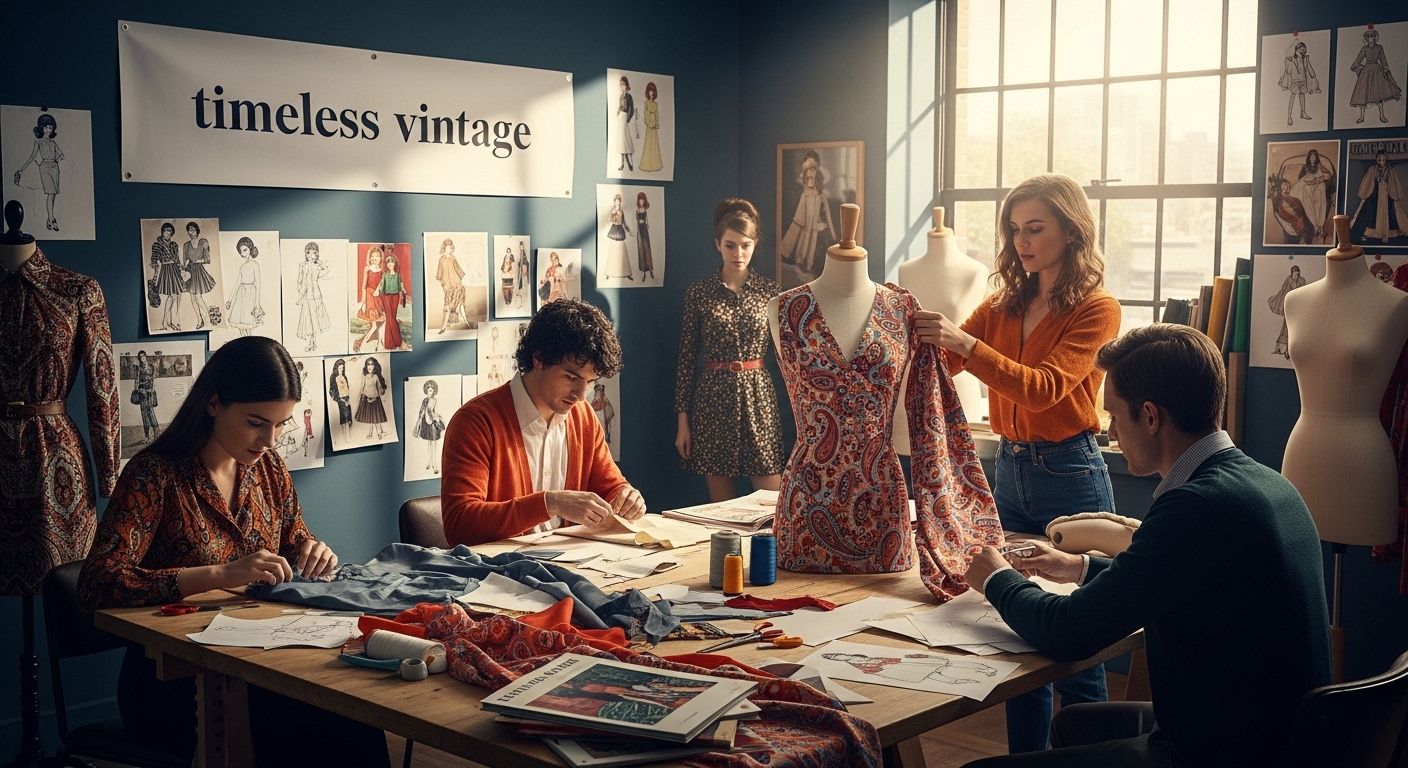What Defines 1960s Fashion?
- Emma

- Sep 24
- 8 min read

The 1960s shook up the world with more than just psychedelic patterns and swinging miniskirts. Half of all British teenagers in 1966 spent a third of their weekly income on fashion. Most people think of that era as a tie-dye flashback. Yet fashion became a form of rebellion and statement for millions, turning what you wore into a symbol of freedom, creativity and social change.
Table of Contents
Quick Summary
Takeaway | Explanation |
Fashion as Social Expression | The 1960s used fashion to represent political and personal views. |
Youth Culture Redefined Style | Young people changed fashion to reflect independence and creativity. |
Global Influences Shaped Trends | International designs transformed local fashion into a global conversation. |
Iconic Figures Influenced Fashion | Designers and musicians redefined styles, promoting cultural and personal identity. |
Legacy Still Resonates Today | The 1960s’ values and aesthetics continue to inspire modern fashion. |
The Cultural Landscape of the 1960s
The 1960s emerged as a transformative decade that fundamentally reshaped societal norms, cultural expressions, and fashion paradigms. This extraordinary period represented more than just clothing trends; it was a profound social revolution that challenged established conventions and celebrated individual freedom.
Social Movements and Fashion Rebellion
The decade witnessed unprecedented social movements that directly influenced fashion. Civil rights campaigns, anti-war protests, and feminist movements created a powerful backdrop where clothing became a form of political and personal expression. Young people began using fashion as a visual language to communicate their rejection of traditional societal structures.
Music played a critical role in defining 1960s style. Bands like The Beatles and The Rolling Stones didn’t just create iconic sounds but also pioneered revolutionary fashion statements. Their experimental clothing choices inspired millions, blurring gender boundaries and introducing androgynous elements into mainstream fashion. Learn more about how music influenced vintage fashion.
Global Cultural Influences
The 1960s fashion landscape was remarkably global in its inspiration. According to research from the Fashion and Textile Museum, boutiques in London’s Chelsea district were instrumental in creating a fashion revolution that drew inspiration from diverse global sources:
Moroccan textiles and patterns
Far Eastern design aesthetics
African tribal clothing elements
Indian spiritual and textile traditions
These international influences transformed fashion from a localised phenomenon into a truly global conversation about identity, self-expression, and cultural exchange.
Crucially, the 1960s represented a moment when fashion transcended mere clothing and became a powerful medium for social commentary, personal liberation, and cultural transformation.
Key Fashion Trends and Styles
The 1960s fashion landscape represented a radical departure from previous decades, introducing revolutionary styles that challenged conventional design principles and social expectations. This era witnessed an extraordinary transformation in clothing that reflected broader societal changes.
Mod and Miniskirt Revolution
The mod subculture, originating in London, became a defining aesthetic of the 1960s. Miniskirts, pioneered by designers like Mary Quant, symbolised young women’s newfound social liberation. These dramatically shorter hemlines represented more than a fashion statement - they were a powerful declaration of independence and changing gender dynamics. Explore our guide on classic timeless vintage styles to understand how these iconic designs continue to influence contemporary fashion.
According to research from the British Library, key 1960s fashion characteristics included:
Vivid, saturated colour palettes
Geometric and paisley print designs
Streamlined, androgynous silhouettes
Experimental fabric combinations
Pop Art and Fashion Fusion
Pop Art profoundly influenced 1960s fashion, introducing bold graphic elements and challenging traditional design boundaries. Designers began incorporating vibrant colours, graphic prints, and unconventional materials that mirrored the artistic movement’s rebellious spirit. Clothing transformed from mere fabric into a canvas for cultural expression, blurring lines between fashion, art, and social commentary.
The era’s fashion was fundamentally about challenging norms, celebrating individual creativity, and rejecting outdated sartorial conventions. Every garment became a statement of personal identity, reflecting the decade’s revolutionary ethos.
The following table summarises the key fashion trends and defining features of 1960s style, helping readers quickly identify the era’s most iconic elements.
Trend or Feature | Description | Key Example/Influencer |
Miniskirt Revolution | Dramatically shortened hemlines representing liberation | Mary Quant |
Mod Fashion | Streamlined, androgynous silhouettes, geometric prints | London Mod Subculture |
Pop Art Influence | Bold, graphic prints and vibrant colours | Pop Art Movement, Designers |
Androgynous Elements | Blurring of gender boundaries in style | The Beatles, Mick Jagger |
Global Inspirations | Incorporation of Moroccan, Indian and African aesthetics | Chelsea Boutiques |
Influences on 1960s Fashion
The 1960s fashion landscape emerged from a complex web of cultural, artistic, and social influences that transformed clothing from a mere functional necessity into a powerful form of personal and political expression. This decade represented a pivotal moment where fashion became a dynamic reflection of societal transformations.
Youth Culture and Rebellion
Youth culture became the primary driving force behind 1960s fashion innovations. Teenagers and young adults were no longer content to follow traditional dress codes established by previous generations. Instead, they sought clothing that symbolised their desire for independence, creativity, and social change. Discover more about the era of transformative fashion and understand how young people revolutionised style.
According to research from the BBC’s British Style Genius, key influences included:
Emerging music subcultures
Anti-establishment sentiment
Economic prosperity
Increased global cultural exchange
Global and Artistic Inspirations
The 1960s fashion revolution was profoundly influenced by global artistic movements and international cultural exchanges. Pop Art, with its bold colours and graphic designs, directly impacted clothing aesthetics. Designers began viewing fashion as a canvas, incorporating avant-garde artistic principles into garment design.
Musical icons like The Beatles, alongside emerging designers such as Mary Quant, played crucial roles in democratising fashion. They challenged traditional design boundaries, introducing androgynous styles and experimental silhouettes that celebrated individual creativity and rejected rigid societal norms.

Ultimately, 1960s fashion was not just about clothing - it was a radical form of social communication, representing a generational shift towards personal freedom, artistic expression, and cultural transformation.
Iconic Figures and Their Impact
The 1960s fashion revolution was driven by visionary individuals who challenged established design conventions and redefined style as a form of personal and cultural expression. These iconic figures transformed fashion from a top-down industry into a dynamic, democratised art form.
Fashion Designers as Cultural Revolutionaries
Mary Quant emerged as the quintessential designer of the decade, democratising fashion through her innovative designs. She popularised the miniskirt, transforming it from a mere clothing item into a powerful symbol of female liberation and youth rebellion. Explore the stories of influential British fashion pioneers to understand their groundbreaking contributions.
According to research from the Victoria and Albert Museum, key influential designers included:
Mary Quant: Miniskirt innovator
Barbara Hulanicki: Biba boutique founder
John Stephen: Men’s fashion revolutionary
Marion Foale and Sally Tuffin: Avant-garde design pioneers
Musical and Cultural Icons
Musical performers played an equally transformative role in shaping 1960s fashion. The Beatles, with their evolving style from clean-cut suits to psychedelic prints, demonstrated fashion’s potential as a form of artistic and personal expression. Mick Jagger and other rock icons challenged gender norms, introducing androgynous elements that became defining characteristics of the era’s style.
These figures did more than wear clothes - they used fashion as a language of rebellion, creativity, and social transformation, turning garments into powerful statements of identity and cultural change.
This table compares the contributions and distinctive impacts of key 1960s fashion designers and music icons, allowing readers to see at a glance who shaped the decade’s style.
Influential Figure | Field | Signature Impact | Notable Contribution |
Mary Quant | Fashion | Miniskirt innovation, democratised fashion | Empowered young women, symbol of liberation |
Barbara Hulanicki | Fashion | Biba boutique, affordable avant-garde style | Made high style accessible on the high street |
John Stephen | Fashion | Revolutionised men’s fashion | Popularised mod menswear, bold tailoring |
The Beatles | Music | Androgynous and evolving fashion statements | Broke gender boundaries, set global trends |
Mick Jagger (The Rolling Stones) | Music | Flamboyant clothes, challenged gender norms | Embodied rebellious, expressive style |
The Legacy of 1960s Fashion Today
The revolutionary spirit of 1960s fashion continues to reverberate through contemporary design, demonstrating an extraordinary capacity to transcend temporal boundaries. Far from being a mere historical footnote, the decade’s aesthetic principles remain profoundly influential in modern fashion and cultural expression.
Continuous Design Inspiration
Contemporary designers consistently draw inspiration from the 1960s, reinterpreting iconic silhouettes, bold colour palettes, and experimental design approaches. The era’s commitment to individual expression and boundary-pushing creativity continues to challenge conventional fashion norms. Explore how vintage styles evolve through time and understand the enduring impact of this transformative decade.
According to research examining fashion’s visual history, the 1960s legacy manifests through:
Recurring minimalist design principles
Celebration of gender-fluid fashion
Emphasis on individual self-expression
Innovative fabric and textile experiments
Social and Cultural Resonance
Beyond aesthetic influences, the 1960s fashion revolution established fundamental principles of personal freedom and social commentary through clothing. Modern fashion continues to embrace these ideals, viewing garments as platforms for communicating personal identity, challenging societal norms, and expressing political and cultural perspectives.
The decade’s radical approach to design transformed fashion from a passive industry into an active form of cultural dialogue, a legacy that remains powerfully relevant in contemporary style conversations.

Capture the Spirit of Real 1960s Fashion Today
Are you still searching for genuine ways to express your individuality after exploring what truly defined 1960s fashion? The article highlighted the era’s fearless embrace of creativity and liberation through clothing, yet recreating an authentic mod or pop art look can feel impossible with modern mass-market choices. Many crave the vivid colours, unique prints, and personal statement pieces that set 1960s style apart, but struggle to find real vintage items that tell a story and genuinely reflect social change.

Experience the excitement of wearing authentic vintage with My Vintage. Our carefully curated collection features original garments and accessories from the 1960s, perfect for those who value authenticity, sustainability, and timeless British style. Discover pieces that echo the cultural and artistic influences you read about in the article. Start your journey towards individual expression and connect with fashion history now by exploring our full range at My Vintage.
Frequently Asked Questions
What were the key fashion trends of the 1960s?
The 1960s introduced revolutionary styles such as the miniskirt, mod fashion, bold graphic prints from the Pop Art movement, and androgynous silhouettes that reflected social changes and youth rebellion.
How did music influence 1960s fashion?
Music played a critical role in shaping 1960s fashion, with bands like The Beatles and The Rolling Stones inspiring new styles and encouraging the blurring of gender boundaries through their unique clothing choices.
What social movements impacted 1960s fashion?
The decade’s fashion was heavily influenced by civil rights campaigns, anti-war protests, and feminist movements, with clothing becoming a medium for personal and political expression, reflecting a rejection of traditional societal structures.
Who were some influential fashion designers in the 1960s?
Key figures included Mary Quant, known for popularising the miniskirt; Barbara Hulanicki, founder of Biba; and John Stephen, who revolutionised men’s fashion, all of whom contributed to the era’s dynamic style changes.
Recommended








Comments